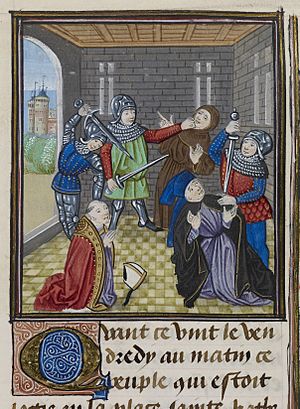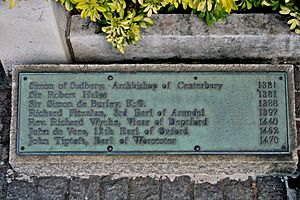Simon Sudbury facts for kids
Quick facts for kids Simon Sudbury |
|
|---|---|
| Archbishop of Canterbury Primate of All England |
|

A 15th-century picture of the murder of Archbishop Simon of Sudbury and Sir Robert Hales at the Tower of London.
|
|
| Appointed | 4 May 1375 |
| Enthroned | Unknown |
| Reign ended | 14 June 1381 |
| Predecessor | William Whittlesey |
| Successor | William Courtenay |
| Other posts | Bishop of London |
| Orders | |
| Consecration | 20 March 1362 |
| Personal details | |
| Born | c. 1316 |
| Died | 14 June 1381 (aged 64–65) |
Simon Sudbury (born around 1316 – died 14 June 1381) was an important leader in the church and government in England. He served as the Bishop of London from 1361 to 1375. After that, he became the Archbishop of Canterbury, which is the most senior bishop in the Church of England. In his last year, he was also the Lord Chancellor of England, a very high position in the government. Sadly, he died a violent death during a big uprising called the Peasants' Revolt in 1381.
Contents
Life of Simon Sudbury
Simon Sudbury was born in a town called Sudbury in Suffolk, England. His father was Nigel Theobald. Simon went to study at the University of Paris, which was a famous university. Later, he became a special helper, called a chaplain, for Pope Innocent VI. This Pope was one of the "Avignon Popes," who lived in Avignon, France, instead of Rome. In 1356, the Pope sent Simon on an important trip to meet Edward III of England, who was the King of England at the time.
In 1361, Simon became a high-ranking church official in Salisbury. In October of that year, the Pope chose him to be the Bishop of London. Simon officially became a bishop on March 20, 1362. He quickly started helping King Edward III as an ambassador, traveling to other countries to represent England, and in other important ways. On May 4, 1375, he became the Archbishop of Canterbury, taking over from William Whittlesey. For the rest of his life, he supported John of Gaunt, a powerful prince and son of King Edward III.
In July 1377, after King Edward III passed away, Simon of Sudbury had the important job of crowning the new king, Richard II. This happened at Westminster Abbey. In 1378, a religious reformer named John Wycliffe appeared before Simon at Lambeth Palace. Simon only took action against Wycliffe because he was under a lot of pressure from others.
In January 1380, Simon Sudbury became the Lord Chancellor of England. This meant he was the King's chief minister and head of the government. However, the rebellious peasants saw him as one of the main reasons for their problems. They were very angry about a new tax called the poll tax, which Simon had helped introduce.
The Peasants' Revolt and Simon's Death
The angry peasants released a priest named John Ball from prison in Maidstone. Then, the rebels from Kent attacked and damaged Simon's properties in Canterbury and Lambeth. Next, they rushed into the Tower of London, where Simon was. The guards at the Tower simply let the rebels in. This was because Simon was so unpopular due to his role in the new poll tax.
Simon Sudbury was saying Mass, a church service, in St John's Chapel inside the Tower. The rebels dragged him out to Tower Hill. They also took Sir Robert Hales, who was the Lord High Treasurer (in charge of the country's money). A writer named John Stow, who wrote about this two centuries later, said that Simon was beheaded with eight furious sword blows to his neck. One of these blows also cut off the fingers from one of his hands.
After his death, Simon's body was taken to Canterbury Cathedral. However, his head was removed after six days by William Walworth, the Lord Mayor of London. His head was then taken to Sudbury, his hometown. It is still kept at St Gregory's Church, a church that Simon had partly rebuilt. Simon and his brother, John of Chertsey, also started a college in Sudbury. He also helped with some building projects in Canterbury. His parents, Nigel Theobald and Sara, are also buried at St Gregory's.
In March 2011, scientists used a CT scan on Simon Sudbury's mummified skull. This happened at the West Suffolk Hospital. The goal was to create a facial reconstruction, which means rebuilding what his face might have looked like. This reconstruction was finished in September 2011 by an expert named Adrienne Barker at the University of Dundee.
Simon's tomb is in Canterbury Cathedral. It holds his body, with a lead cannonball placed where his head should be. The stone tomb no longer has its original gold-colored statue, which was destroyed during the English Reformation. However, the beautifully carved stone cover above the tomb is still there. There is an old tradition where the mayor of Canterbury places a wreath of red roses on the tomb every year on Christmas Day. This is done to remember the good things Simon did for the city.
Simon Sudbury's Coat of Arms
Simon Sudbury's coat of arms was a special design. It showed a talbot hound sitting down within a border that had wavy edges. You can still see this design carved in stone on a wall in the main part of Canterbury Cathedral. The town of Sudbury also uses a talbot hound sitting down in its own coat of arms. This is a way to remember Simon Sudbury.
See also
 In Spanish: Simon Sudbury para niños
In Spanish: Simon Sudbury para niños


